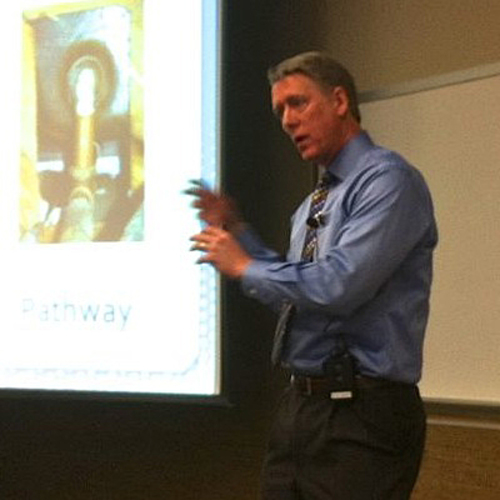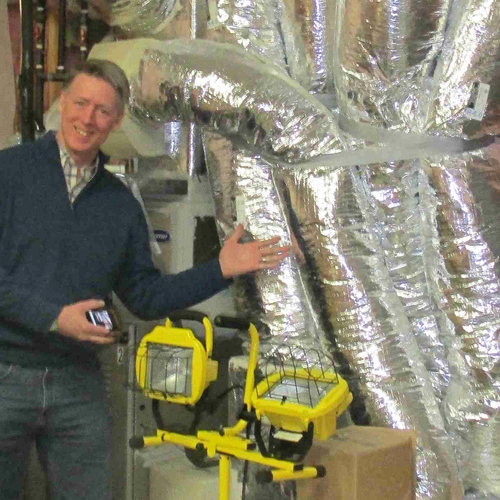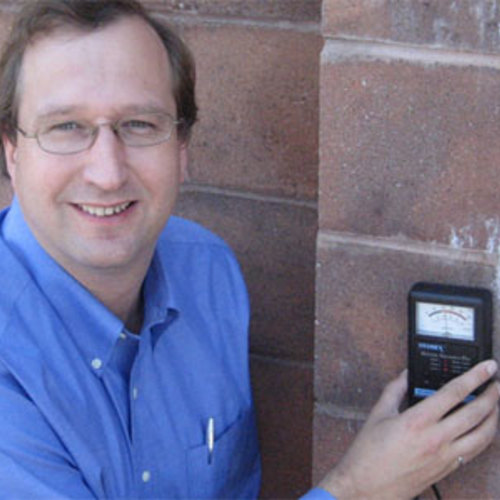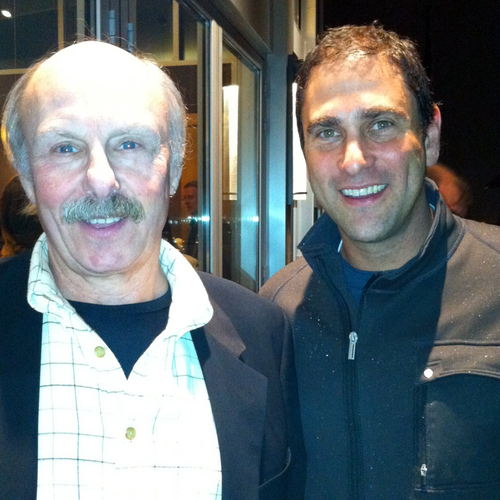Allison Bailes was in town to talk to the Building Science Discussion Group, and Phil and I thought we’d grab him to share a conversation with our listeners. (For more on the Building Science Discussion Group, see “Steve’s Garage.”)
Allison is the founder of Energy Vanguard, an Energy Star provider and training organization. He’s also a green building advisor here on GBA, where he lends some warm-climate experience to the more cold-climate-oriented crew.
After briefly talking about juggling and his choice to be left-handed, we covered many topics, mostly surrounding the requirements of the new Energy Star specifications and his company’s approach to auditing and designing mechanical systems.
The Highlights
Moscow Mule Cocktail. Since we recorded in the morning, on a workday, we did not consume these during the podcast, but Phil and I enjoyed them later. It’s 1½ oz. vodka and the juice from half a lime, added to ice in a highball glass or beer glass, and topped with Ginger Brew (Jamaican style). Garnish with a twist or wedge of lime. Happy Summer, everybody. For many, many more cocktail ideas, browse Fine Cooking’s cocktail recipes section.
Tell us about Energy Vanguard and then tell us what’s new in Energy Star Version 3. Allison shares how his company came to be and what they do. He also gives us a little history on Energy Star and the big difference that Energy Star 3 brings. It’s going to be the HVAC contractor who’ll have to make the most adjustments.
How do you quantify and discuss mean radiant temperature and its impact on naked people? Allison helps bring an understanding to the least understood of the four major factors of thermal comfort (temperature control, humidity, air movement, and mean radiant temperature).
Talk to us about having an architect on staff to help integrate design and mechanical engineering. Allison talks about how his office moves through the design of a mechanical system along with the building. He also explains how Manual J, T, and D designs add to the project.
Cost offsets: In a mixed climate, is it still a good strategy to improve the thermal envelope in order to reduce the size of the mechanical equipment and anticipated operating costs? And how is that done? After a discussion of the differences in climate, Allison explains an approach very similar to that used in a cold climate.
What’s the most important piece of advice you have for someone setting out to perform a serious renovation project? It’s not a big surprise that improving the building envelope gets top priority in Allison’s response.
We’ve noticed that you’ve embraced the “Pretty Good House” concept in your blogs. What has attracted you to this concept? Allison talks about seeing the blogs on GBA from Mike Maines and thinking, “What a great idea”— to move away from prescriptive programs toward a more independent method of improving our housing stock.
What’s the strangest thing you’ve seen built into a project? Allison shares a nice story about his in-laws’ home.
Finally, Phil shares the song of the episode, “This One’s Different,” by the Georgia band Howler. Also be sure to check out Allison’s Energy Vanguard blog. Remember, you can always e-mail us at [email protected] or visit us on Facebook to let us know what topic you’d like us to cover for a podcast.
Thanks for listening, everyone. Cheers.
OFFICIAL TRANSCRIPT
Chris Briley: Hey, everybody, welcome to the Green Architects’ Lounge podcast. I’m your host, Chris Briley.
Phil Kaplan: And I’m your host, Phil Kaplan. Nice to see you, Chris.
Chris: We’ve got a special guest with us today. Dr. Allison Bailes III is the founder of the very popular blog Energy Vanguard, a contributor to GBA, a recovering physicist, the program manager at Southface Energy Institute, home performance manager of the Hoots Group, a juggler, a left-hander, and — brace yourselves — he’s a man! Allison, thank you for coming in.
Allison Bailes: Well, thank you, guys. It’s good to be here.
Chris: We’ve discovered that you’re left-handed now.
Allison: Yes, as of 2007.
Phil: Tell us the story!
Chris: You were born right-handed …
Allison: Yeah, I just evolved. I felt like a left-hander in a right-hander’s body. In 2006 I became a juggler. I had taught myself to juggle in 1993, but in 2006 I became obsessed. When you’re juggling, it’s important to be as uniform as possible with both hands. If you’re a right-hander, you have to practice more with your left hand, and vice-versa. So, I decided if I want to get better at juggling, I should switch everything to the left hand. In 2007 I started with three things. One was washing the dishes. Instead of holding the sponge in my right hand, I would put it in my left hand. Brushing my teeth and eating were the other things I started with.
Chris: So, left-handedness is a lifestyle choice …
Phil: Hey, Chris, why don’t you tell us about today’s drink before we dig into this further?
Chris: This is a Russian cousin to the Dark and Stormy. It’s called the Moscow Mule. [The guys talk about the drink recipe.]
Phil: In keeping with the Green Architects’ Lounge tradition, we’ve got a song to go with the drink. I pulled out an album by one of my favorite bands, Howler, and found out they’re from Georgia, where Allison is from. The name of the album is “America, Give Up,” and the name of the song is “This One’s Different.”
Chris: OK, back to green architecture. Personally, I have questions about Energy Star 3. No one in our building science discussion group knows anything about it. What’s the big difference between Energy Star 2 and 3? And what are the little differences?
Phil: But first, tell us about Energy Vanguard, and why you would know about this in the first place.
Allison: Energy Vanguard is a HERS training provider and rating provider. We do HVAC design and architecture. We’ve been a provider for about three years now and got an award last year from Energy Star — the Leadership in Housing Award for qualifying an outstanding number of Energy Star homes, which was nearly 300.
We don’t do ratings ourselves; we are a provider only for independent raters. We’ve got some companies that are really good at qualifying Energy Star homes. There’s a company in Nashville called E3-Innovate, a great home-performance and rating company. Another company in Macon, Ga., did over 100 ratings of Energy Star homes last year. In our work as a rating provider, we have to know about Energy Star.
The Energy Star program started in the mid-1990s. It involved some energy modeling with rating software and one inspection at the final. The second version of Energy Star came out in 2006 and introduced the second inspection at pre-drywall, which is one of the best things to have come out of the Energy Star program: getting the rater into the house — a third-party verifier — to look at the envelope, look at the mechanicals, and find problems before they get covered up. And Energy Star still kept the final inspection, the testing, and the energy modeling.
Now we’re in the transition to Energy Star 3; we can certify homes as Energy Star 2.5 or 3 at the moment. As of July 1, they will all be Energy Star 3. Instead of the one checklist we had before, Version 3 has four checklists: No. 1 for the builder, on water management; No. 2 for the rater, a thermal enclosure rating checklist; No. 3, the HVAC rater checklist; and No. 4, a checklist for the HVAC contractor.
The HVAC contractor has the biggest adjustment — because the HVAC industry is good at certain things, but not good at getting the whole thing right. I’m generalizing here. There are some very good HVAC contractors who are good at the whole process — the system, the sizing, the design, and the distribution, which is often neglected, especially in our part of the world where we mostly have forced-air systems.
Version 3 requirements are pretty stiff. There are a lot of requirements for airflow, and the design requirements are heavy. But, someone besides the contractor, like Energy Vanguard, can do the design and complete that part of the HVAC contractor’s checklist. And the contractor does the part for installation, while the rater does the rating checklist.
HVAC is the biggest change in Version 3. Version 2 basically required that the contractor had to do a Manual J and size the system accordingly, and match the indoor and outdoor coils for air-conditioning, and have low duct leakage. Those requirements were relatively simple — although one of the biggest battles I had over and over was with the rating provider. Our raters would send us their files for quality assurance, so we’d have to look at the energy model and go through the documents, look at the Manual J, and look at the system that was installed. If the system was too big — if the Manual J said this house needed 2 tons of air-conditioning and the contractor put in 3½ tons of air-conditioning, that does not meet the Energy Star requirements of no more than 15 percent oversizing. So, it was always a battle.
Usually, if a contractor wanted to put in 3½ tons of air-conditioning, instead of coming up with a 2-ton Manual J, they could maybe fudge the numbers a little bit and come up with a 3½-ton Manual J, so the Manual J and the system were in agreement.
But, I would look through the Manual Js and find all sorts of mistakes. They would change the design temperatures. You’re supposed to use the correct indoor and outdoor design temperatures for the location of the house. You’re supposed to put in the correct number of people because people add heating and cooling load to the house. For cooling, the number of people has an effect because each person gives off 230 Btu per hour of sensible heat, and that goes into the calculation.
The rule is that the number of people should equal the number of bedrooms in the house, plus one. So, a three-bedroom house would have four people. I’ve seen a Manual J with a three-bedroom house that had 11 people living in it. Another provider had one with 25 people. This is one of the ways you can cheat on a Manual J.
Energy Star requires the Manual J to be in agreement with the size of the system installed. If you change the parameters of the load calculation, and the provider and the rater don’t look deeply into it, you can get the oversize system anyway in an Energy Star house. And there are some out there like that.
Chris: You’re warm climate focused. We and GBA have been accused of being cool climate focused.
Allison: Well, Energy Star has a requirement for limiting the size of air conditioners, but there’s no similar requirement for limiting the size of heating systems. You want the system size as close to the actual loads as possible because an air conditioner does two jobs. To do the dehumidification properly, it needs a longer run time. The more oversized a system is, the shorter the run time is.
Chris: You ever run a dehumidification system through ductwork that is not air-conditioning?
Allison: There are some houses that have them, and those are great. Air conditioners are only going to be dehumidifiers when they’re running. The worst days for humidity in houses are what some people call 80/80 days. It’s 80 degrees outside, so it’s not hot; the air conditioner is not going to be running much because there is not much of a sensible cooling load. If it’s 80 degrees and cloudy and the humidity level is 80 percent, the air conditioner won’t be running enough to dehumidify the house. That’s when a dehumidification system will help keep the house comfortable.
Chris: I want to get to mean radiant temperature. “Naked People Need Building Science” was the title of one of your blogs. Let’s say a room has a large glass wall facing north. It can suck the heat from you or radiate heat toward you.
Allison: The issue of mean radiant temperature is not one that most people have to deal with. Different factors affect your comfort, chief among them air temperature. If they’re uncomfortable in a house, the first thing most people check is the thermostat. Humidity is the second most important factor, but most people check the temperature first. Another one is air movement. In summertime we want the ceiling fans on; in winter, we don’t want drafts blowing on us.
The fourth one is mean radiant temperature, and that’s important, especially in certain rooms. In the South we have bonus rooms, also called frogs — finished room over garage. These rooms often have comfort problems, and a lot of them have to do with mean radiant temperature. I’ve been in many attics behind the kneewalls in those bonus rooms, and what you see is fiberglass batts stuffed in 2×4 bays, and they’re falling out and not making good contact with the drywall. The cold air in the attic in winter, or the hot air in summer, gets right up against the sheetrock, so the walls are cold in winter or hot in summer. Someone in that room might feel uncomfortable, even if the air temperature is good, because of the net radiant heat transfer between them and the walls.
You alluded to windows earlier. In new houses we’re putting in double- or triple-paned windows, and they’re not as much of a problem as the single-paned windows in older houses — although they’re worse than walls. In an older house, if you stand next to a single-paned plate glass window on a cold night, your body is losing heat to that window and it’s not sending much back to you.
Chris: You have an architect on staff, which is unusual in your field of energy auditing.
Phil: Yes, energy affects the shape and form of a house. Talk to us about that.
Allison: I hired an architect two years ago and immediately put him through the HERS class, so he learned about building science and energy modeling. His background is in commercial architecture, most recently high-end restaurants, and now he’s a certified energy rater with us. He doesn’t go out and do ratings, but when he designs a house or designs HVAC for a house, he does the rating file, and we can pass that along to the client if he or she wants to get the home Energy Star rated.
So, in addition to teaching him home energy rating stuff, our architect also learned HVAC design. We use the software Right-Suite Universal from Wrightsoft.
HVAC design is four steps. The first is calculating the heating and cooling loads; that’s Manual J. Manual J is a code designed by the Air Conditioning Contractors of America. The second step is Manual S, or equipment selection. Once you know the loads, room by room — how many Btu per room for heating and cooling — that tells you how many cubic feet per minute of air flow you need for a forced-air system. Once you have that, you select equipment and figure out how to zone the house.
Once you have equipment selected, the next step is air distribution, or Manual T, which decides where you’ll put the vents in a forced-air system, the supply vents and the return vents, what kinds of grilles and registers you’ll use, and how much throw you’ll get so that there is proper air mixing in the house. That’s not as important, by the way, in a high-performance home.
Chris: There’s not as much heat loss through the envelope.
Allison: The standard way of installing a duct system is to place supply vents under windows and near doors. Typically, older homes have a lot of load there. But high-performance homes have better windows, so we can place supply vents toward the center of the house and shorten the duct system, which helps with installation, cost, and efficiency. So that’s Manual T, deciding how to get the air distributed. And then there’s Manual D, for duct design — connecting the equipment to the vents, etc.
Phil: That’s cool! Makes me want to take a HERS class. Can you do a northern version?
Allison: We’ve had northerners in our class before. Recently a guy from Massachusetts came down and took our class.
Phil: Let’s talk about cost offsets to justify improving the envelope. If we improve the envelope to some extent, then we can start extracting mechanical systems, including distribution. Is that still possible in mixed hot/humid climates? Can we not supply every room? Is that part of the strategy? Can we eliminate a large part of the heating system? How do you make that work?
Allison: Absolutely. That’s what Passivhaus is all about — reducing the loads to such a small number. There was an article a few years ago about a house in Illinois so well sealed and air tight that you could heat it with a blow dryer. In a heating climate, it’s a bit easier to do that than in a cooling and humid climate like the Southeast. We’re not just worried about temperature but also about humidity, and getting dehumidification from the cooling system is important.
Chris: We get people who move here [to Maine] and want to install air-conditioning. They haven’t lived here and made the adjustment yet. But then we put thermal mass in their house, and they say, “You’re right, Mr. Architect.” We hear that once in a while.
Phil: We also can avoid that conversation by installing air-source heat pumps, which have a cooling component built in.
Allison: When you make the house better and better, you can save some money by reducing the size of the equipment you install or, at the next level, change the type of equipment you install. You can use ductless minisplit heat pumps; your distribution system is the air handlers themselves, placed throughout the house. Can you just supply the heating and cooling in certain rooms? Yes. In a small bathroom, in the interior of the house, there’s not really a need to install a vent in that room.
Chris: For the lion’s share of houses out there, the HVAC designer is the HVAC contractor. What’s the process for a client who comes to me, the architect, and asks me to design the HVAC?
Allison: If you have a really good envelope and you put the HVAC distribution system inside the envelope, there’s more leeway for letting the HVAC contractor do things. However, you can still have comfort problems because of poor distribution. A smart contractor can make sure distribution is handled properly.
Chris: What is your first piece of advice about renovation?
Allison: Pay attention to the envelope first. Don’t add insulation to an older home if it doesn’t have the proper flashing and drainage plane on the outside. If you do a complete gut rehab from the inside and add insulation to the walls, you might have moisture problems. The envelope comes first, always.
I saw a house under renovation in Atlanta, in which they were creating conditioned space from what had been an unconditioned attic. They raised the roof a little bit, insulated the roof line, and used blown cellulose. Not long after, the contractor had to return and change most of the decking on the roof. This was in wintertime. The warm, moist air in the conditioned space had gotten through the cellulose, and the cellulose had sagged, and the warm, moist air pockets in the attic, against the roof deck, caused condensation, and the roof deck started to buckle.
Moisture is one of the biggest things people need to understand. People worry about vapor retarders and vapor barriers, but a lot of the moisture comes from infiltration, not from the diffusion process — especially in the Southeast.
Phil: We’ve talked a lot in our building science discussion group about the Pretty Good House. What drew you to it?
Allison: I saw it on GBA — I saw Mike Maines’s article about it — and thought, wow, what a great idea. There’s a lot of frustration out there about some of the programs — Passivhaus takes it too far, LEED for Homes is going through requirement changes, Energy Star 3 is too hard. There’s some merit to those arguments, but the programs still do have a role. The Pretty Good House movement is a good idea because it gives those of us in the field, who aren’t creating the program guidelines, the chance to figure out how we would do it if we had our own program.
Maybe we don’t want to go as far as the other programs, but we want to build something that’s pretty good. There is still a need for third-party verification and the requirement to get the air handler and distribution inside the envelope. Let’s stop putting ducts in unconditioned space.
Phil: LEED houses and Passivhaus are not climate-specific, and Pretty Good House will allow us some flexibility to do that. It’s not as prescriptive. It will get to things that are more right.
Chris: There’s a book in the works.
Yeah, there will be leeway for builders to be creative. You’re not submitting anything to anybody for certification. You’re just paying attention to each feature of what a Pretty Good House needs or wants.
[The guys joke about “reinvented physicists.”]
Allison: On my blog I write about how the physical world works — for example, how a radiant barrier works, or the second law of thermodynamics. That law is really important; in any HERS rater or building science class you take, you come to the second law of thermodynamics.
Building science boils down to very few things: controlling the flow of air, heat and moisture. Heat naturally wants to move from areas of high temperature to lower temperature; moisture moves from where it’s wet to where it’s dry; and air moves from high pressure to low pressure areas. That’s the second law of thermodynamics.
Phil: We need to know a lot more about the universal rules.
Chris: What’s the strangest thing you’ve seen a homeowner or builder or architect do?
Allison: The strangest was probably at my in-laws’ house. I did some work there and was crawling around in the attic. The insulation had turned black — a telltale sign that a lot of air was moving through the insulation. I peeled it back and saw a 2-ft.-wide by 6-in.-deep hole in the sheetrock. I looked through it and saw the back of the refrigerator.
The house was built in 1962, but 10 years ago they had the kitchen redone. The contractor decided that since the fridge was sitting in a niche behind cabinetry, it needed to be vented to the attic, and he cut a big hole in the Sheetrock. And that thing drew a lot of air. The heat coming off the fridge helped the stack effect even more. A hole of that size increased the blower-door test by 700 cfm. Just by sealing that hole, it made a pretty big dent in the blower-door test. The refrigerator effect…
[Allison reveals he’s a new, full advisor on GreenBuildingAdvisor.com, and surprises Chris and Phil with the news that they too will be welcomed onto the advisory board.]
Weekly Newsletter
Get building science and energy efficiency advice, plus special offers, in your inbox.
















5 Comments
Some perspective about it from RIBA
Very short comment by Richard Saxon, RIBA Client Design Advisor, at NBS TV, on the issue of BIM and lowering of carbon emissions in construction.
BIM opportunities - Part 10: Does BIM reduce risk?
http://www.thenbs.com/nbsTV/BIM/index.asp
(Free login required)
Saxon has some insightful remarks on Contract Management - to date it has been about managing failure. BIM may bring our industry closer to being like the Japanese construction environment, where you have a one-page contract, which isn't based on what you should do when you fail. And that in future, the savings that you make - fewer of them are going to end up as profits in your pocket.
The only point that I would try to add to what an individual such as Paxon would speak of (Paxon relates the impetus of taking out costs, to the one of taking out Co2 emissions), is that in Japan, we need to see the construction industry within the wider production economy and environment. That is, that standards for production for a variety of end products in those parts of the world, may be different to those we tend to accept over here.
I would refer folk to writers such as Kaplan and Cooper (published widely in the Harvard Business Review), who have written for decades about cost analysis, management accounting, quality control, production methods and so forth. I can see a gap emerging in knowledge about things like management accounting, between those who compile our new building and procurement contract sets - and those who have to work with those contracts day to day.
It used to be the case, in the old days, that the various professional institutes and contractors rep bodies would sit around together, and work out what the contract ought to be for building or civil work. But that is no longer the case. Contract drafting for construction nowadays, appears to be driven more and more by management consultants and management accountants. Those who hale from the stable of Kaplan and Cooper, rather than from any particular construction professional institute.
Kaplan and Cooper Reference
Kaplan, R. S., & Cooper, R. (1997). Cost & Effect, Using Integrated Cost Systems to Drive Profitability and Performance. Boston, MA: Harvard Business School Press.
(Easy enough to read reference, which goes through the 'nuts & bolts' basics of management accounting I found)
Training in how we build
I came across a useful little set of broadcasts recently, that the Green Architects Lounge folk may care to take note of, on the United Kingdom based industry, at NBS TV.
http://www.thenbs.com/nbsTV/BIM/index.asp
(Free login required)
David de Yarza, BIM Director at Lydig Construction, Inc. USA, spoke briefly in the three minute video broadcast: BIM opportunities - Part 9: Is the industry ready? You have to build the model in the computer the way you would build it in the real world, to really get the benefit.
Radboud Baayen, of STABU in the Netherlands also had a nice way of putting it. BIM makes the architect aware of the consequences of what his choices are for the rest of the construction industry.
Most of the video broadcast interviews and round tables included on the NBS BIM section are worth the time and effort. All the best, B.
A/C sizing referencing compare 2 stage and to Variable
Will the E-Star consider, some fact that, a first staging A/c of 2 stages and Dual compressor resulting in 3-Staging, i.e. 18k + 42k = a 5t, or 18+ 24 then both are a 3.1/2 ton..can mean the a/c was sized for that first or second stage?
All then too, is where the first staging is CFM programmable/ set and resettable, toa perfect, i.e.) 340 or less, cfm/ton to wring moisture out in a first stage. OR conversly the 2nd compressor (or staging) can have the 340 cfm/t and the first stage can be for mostly super efficient total cooling of 500 cfm/ton, in certain applicable situations.
Dehumidistat as well as a/c mode sensing can be over-linked to so do.
(please see "Air Source or GT " GBA- search geotherrmal)
When does it consider the Hot Water may determine a size of the compressor?
Instant HW and on-Demand WHILE in Heat Recliam recovering heat in cooling simultaneously?
Some have wanted a 3.1/2 t 40- 44,000 BTUh and larger for HW production from a F/Air GTHP that does not incorporate a wtr:wtr separate unit to have been sold and expensively plumbed.
Theory of Collaboration
With construction getting more complex and more specialists involved than ever before - what is a suitable model for collaboration? For anyone trying to attempt higher level research on collaboration in construction (its a difficult paper to read, like much of the best research, but I think the model they present is fairly sound).
A model of cross-disciplinary building knowledge supporting collaboration
G. Carrara, A. Fioravanti, G. Loffreda
CRCnetBASE, offers option to get individual papers here.
ECPPM 2012
http://www.crcnetbase.com/doi/book/10.1201/b12516
Log in or create an account to post a comment.
Sign up Log in